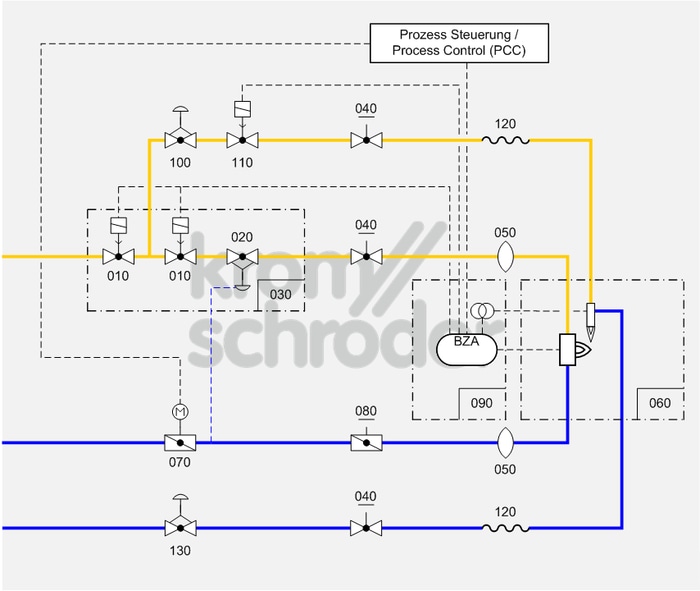KST – KROMSCHRÖDER SYSTEM TECHNOLOGY
Burner control
Single burner system, modulating-controlled

Process control systems
| No. | Component description | Standards and Docuthek |
|---|---|---|
| 010 | Automatic shut-off valve, e.g. solenoid valves for gas VAS
|
|
| 020 | Air/gas ratio control, e.g. air/gas ratio control GIK
Pressure regulators should be designed to be as small as possible. |
|
| 030 | Valve combination VCG, as an alternative to the individual devices automatic shut-off valve (VAS) and air/gas ratio control (VAG) | |
| 040 | Manual adjusting element for gas, e.g. flow adjusting cocks GEHV and GEH | |
| 050 | Stainless steel bellows unit, e.g. Type EKO
|
|
| 060 | Industrial burner for gas with pilot burner, e.g. BIO..L, ZIO..L, BIC..L, ZIC..L
The burner’s flexibility is increased thanks to a pilot burner. The control range can be extended incrementally with an optional integrated pilot burner. |
|
| 070 | Control valve with actuator, e.g. BVA with IC
Select the smallest control valves possible so that the opening characteristic can be fully utilized. Note the residual flow when the valve is closed. |
|
| 080 |
Manual adjusting element for air, e.g. butterfly valve for air BVA with manual adjustment
|
|
| 090 | Burner control unit BCU 480 for pilot and main burner combination, as an alternative to the individual devices automatic burner control unit and ignition transformer
The burner control unit is mounted to the burner on site and ensures simple commissioning of the burner system. |
|
| 100 | Gas pressure regulator, e.g. 60DJZ | |
| 110 | Automatic shut-off valve, e.g. solenoid valves for gas VAS
|
|
| 120 | Stainless steel flexible tube, e.g. ES
|
|
| 130 | Air pressure regulator, e.g. 60DJLZ |
Application
Burner system with permanent pilot burner for processes which require high temperature accuracy and low circulation in the furnace, e.g. crucible and ladle heating, incineration installations, hot-air and steam generators, aluminium smelting furnaces…
The main burner’s flexibility is increased thanks to a pilot burner.
Function
The capacity can be adjusted continuously by activating the air control valve (070) (analogue or 3-point step signal). The pneumatic ratio control system (020/030) controls the gas pressure proportionally to the air pressure and thus maintains a constant air/gas ratio. At the same time, it acts as an air deficiency cut-out. Adjusting valves and/or butterfly valves are used for limiting the air and gas flow rates and for adjusting the air/gas ratio.
Furnace pressure fluctuations have the same effect on the gas and air flow so that the air/gas ratio will remain unchanged.
The pilot burner has its own gas and air supply and is directly electrically ignited and controlled. The pilot flame ignites the main burner and is not switched off once the burner has ignited successfully.
Ignition and monitoring are ensured by an automatic burner control unit (090), which must be approved for continuous operation if the burner is to operate for more than 24 hours, in accordance with EN 746-2.
Note
For burner capacities between 120 and 360 kW, ignition with reduced capacity is required pursuant to EN 746-2:2010 (slow opening gas valves).
The pneumatic ratio control system in conjunction with a defined ignition position of the air control valve is an equivalent alternative to the pilot gas bypass according to figure D.14 in Annex D of EN 746-2:2010. The ignition position of the air control valve is to be monitored using limit switches or pressure switches in the air circuit.
Ignition with up to 50% of the burner rating with a safety time of 3 seconds complies with the requirements of the Standard.
For burner capacities greater than 1200 kW, the valves must be equipped with an automatic valve proving system (TC).
